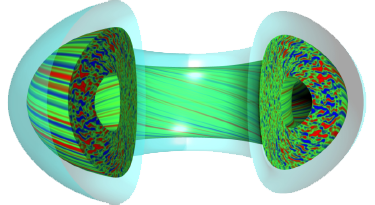Speaker
Description
Permutation entropy (PE) is an information-theoretic complexity measure; it is a single number that represents the information rate to derive the ordinal properties of a time series. In sliding window analysis of a single information channel, a change of PE can indicate a bifurcation of the system state. The method is robust and fast. Therefore, the PE approach is applied on large data sets of highly-sampled plasma data in an automated procedure. The paper reports on the identification of confinement changes by PE in W7-X plasmas revealed in a bulk data survey. Once transitions were detected, spectrogram analyses validated the PE findings.
In order to identify temporal changes of a systems state from a time series, PE quantifies the degree of randomness (resp. disorder, unpredictability) of the ordering of time series data. The complexity of a system measured through PE is determined through the probability distributions of ordinal patterns in consecutive data (taken on a time comb with a delay time D). The calculation of PE is computationally fast since it is based on sorting algorithms rather than distance calculations. Moreover, this approach allows the extraction of robust dynamic properties because PE is invariant for all mappings preserving the order of the data of the time series. PE has been successfully implemented in different science branches e.g. medicine (detection of epileptic electroencephalogram) and economics (characterizing complexity changes in stock market). The widespread applications provide evidence that the method is attractive for in-situ monitoring purposes. Data from hot plasmas are usually processed applying corrections and calibrations. PE is directly applicable provided any analysis step preserves the ordering of the data. In order to use signals for characterizing and forecasting plasma states, PE has advantages from being both computationally fast and robust against noise.
The specific case for applying PE is the analysis of multi-variate, highly sampled time series from an electron cyclotron emission radiometer. Spatio-temporal changes of the plasma states were detected from emissivity changes resulting in significant alterations of the PE in individual channels of the radiometer. While visual inspection of the (noisy) data allows one to conclude on state changes, the time to identify the bifurcation is much reduced when automated analyses with PE were conducted. This acceleration in the processing time allowed us to analyse a large amount of data and to detect systematically changes in the plasma state in a set of experiments. As a result of the systematic survey conducted with PE analysis on a 32-channel-ECE radiometer, the detection of a spontaneous transition to high core-electron temperatures (Te). The bulk processing was employed to investigate the existence and parameter dependencies such as different heating power and density. The reason for the sensitivity of PE was identified (a posteriori) to go along with the occurrence of low frequency emissivity fluctuations, which cease when Te increases in the transition. The identification of spontaneous plasma transition periods was validated by spectrogram analysis.
These results suggest that a complexity measure such as PE is a method to support in-situ monitoring of plasma parameters and for novelty detection in plasma data. PE is therefore proposed as a method for big-data-processing of plasma data. Moreover, the acceleration in processing time offers implementations of plasma-state-detection that provides results fast enough to induce control actions even during the experiment.
| Country or International Organisation | Germany |
|---|---|
| Affiliation | Max-Planck-Institut für Plasmaphysik |

